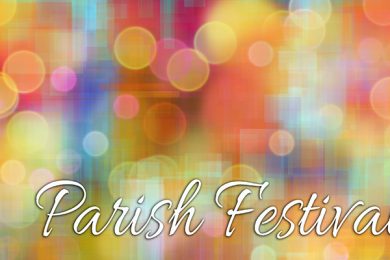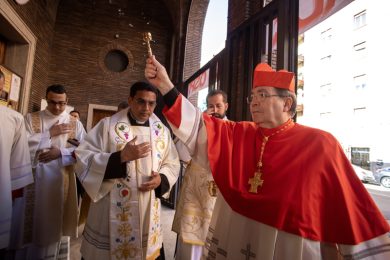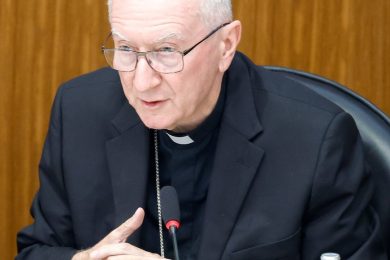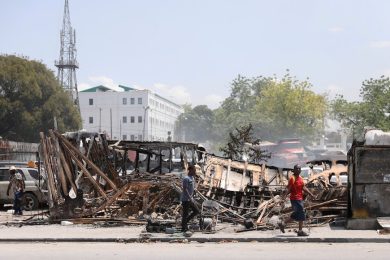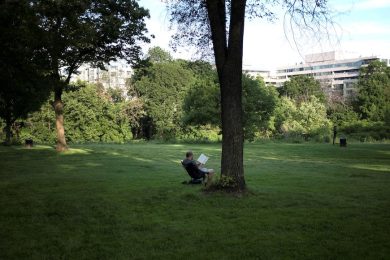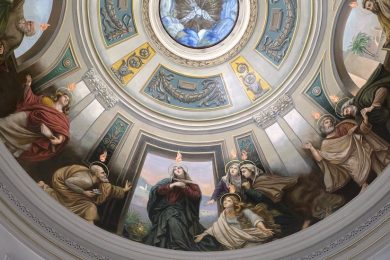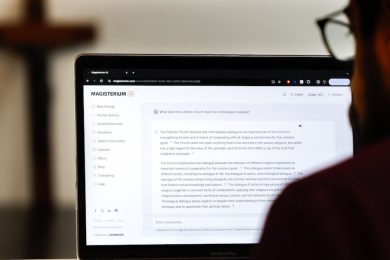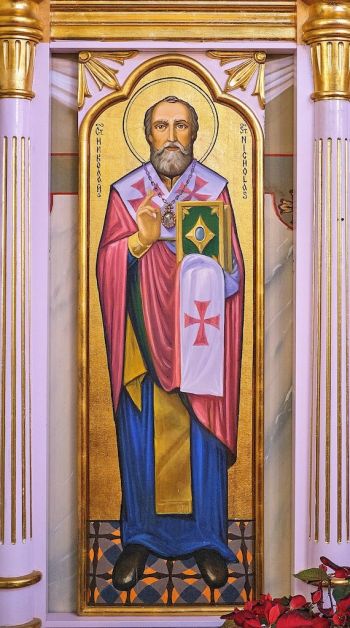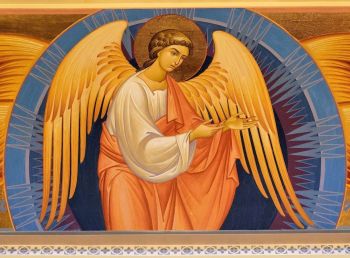By Nicholas Elbers | Catholic News Service
NEW WESTMINSTER, British Columbia (CNS) — Father Mykhailo Ozorovych was proudly showing his visitor the four new icons in Holy Eucharist Ukrainian Catholic Cathedral, and the first one is apparent immediately upon entering the church.
A welcoming image depicts Mary, the Panagia (All Holy). Mary is in the orans, or praying, position, with her raised hands pointing to the icon of Christ in the church dome above her.
When Ukrainian Catholics gather for the Divine Liturgy in the New Westminster church, the outstretched arms of Mary with the child Jesus in her lap now represent them as their hearts and prayers center on Ukraine, where nearly all of them have loved ones.
For Father Ozorovych, the four new icons are more than church artwork. They are helping to strengthen parishioners in faith and culture at a time when the violence in Europe is weighing heavily on the Ukrainian Catholic community.
The Holy Eucharist pastor has been front and center in the media since Russia’s invasion, describing its impact on parishioners who have memories and ties to the region under attack. But during a tour of the cathedral, his focus was on the icons that were added to the ceiling around the church’s dome in November.
The parish commissioned the new icons from the same three Ukrainian iconographers — Serhii Kolodka, Dmytro Vasylkiv, and Oleksii Cherednichenko — who collaborated on the icon of Christ the Pantocrator as well as four surrounding icons of the evangelists in the church’s dome in 2018.
The new icons, rather than being painted directly onto the ceiling, were written on canvas in Ukraine and then flown to Holy Eucharist, where the iconographers installed them before Christmas.
Because of their size, the four new icons might appear to be standalone pieces of sacred art, but they are additions to a “larger map of meaning” that includes icons as well as the Divine Liturgy itself, Father Ozorovych said. The icons must relate to one another and to the wider church. More than simple decorations, they form the structure around which the Divine Liturgy takes place.
“By including this meaning on the walls of the church, the meaning becomes integrated into all,” Father Ozorovych said, pointing out how each new icon was chosen in accordance with the “iconographic canon” — rules and traditions that establish where icons are placed in a church.
“There is a logic and coherence to the placement of the icons. For them to be the windows to heaven, they have to make sense.”
Certain elements are mandatory. Christ, the King of Creation, is always housed in the church’s dome. But slight variations are permitted, such as how he is represented. Some churches could choose to depict him as an architect, while others might show him as a creator or as person within the Holy Trinity. At Holy Eucharist, the icon is of Jesus Christ the Pantocrator, the Ruler of All.
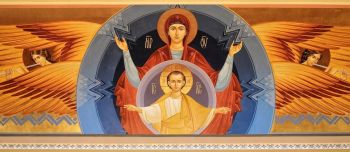
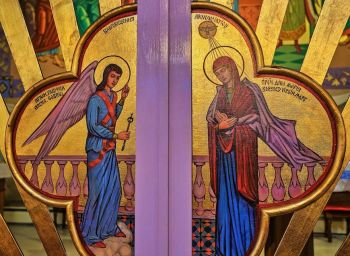
A depiction of the Annunciation on the doors to the sanctuary is also required, as is a place of honor for the most venerated saint within the church’s tradition. In Holy Eucharist, an icon of St. Nicholas, patron of the Byzantine Catholic Church, has that distinction.
In a homily after the installation of the four icons, Father Ozorovych described the significance of each one and how they relate to one another and the wider church. He said they are not just artwork on the church’s walls, but they draw the viewer into the drama of the cosmos.
He commented on an unusual aspect of the new Virgin Mary icon welcoming visitors at the entrance. In her lap is the child Jesus, his hairline receding like an old man’s.
While some might find it a bit off-putting to see the little boy losing his hair, Father Ozorovych said it represents Christ’s eternal nature — the young Jesus in his mother’s arms, the man who will one day die on the cross, and the Word that is present at the creation of the world.
To Mary’s left and right, icons of the Archangels Michael and Gabriel face her, their posture an invitation to join them in reverencing and gazing upon her. Unlike many icons in the church, the angels are not labeled so as to invite the viewer to identify with them more personally.
Opposite Mary is the icon of St. John the Forerunner, or John the Baptist. In his hands, he holds an image of Christ in a chalice, signifying “the sacrifice that frees us from sin,” said Father Ozorovych.
When the project began in 2018, the parish wanted to distinguish the church from its Latin-rite sister churches.
“There has been a great revival of Eastern Christianity and the Byzantine rite,” Father Ozorovych said, and the parish wanted to be as “authentic” as possible. “We are Catholics, but we also have our art, our theology, and our beauty that we want to share with the world.”
The plan now is to continue adding icons, and the parish wants to move its three-year relationship with the iconographers to a new level. A planned visit by the three men in April was put on hold because of the violence in Ukraine. The parish is working to sponsor the families of the iconographers and help them settle in Vancouver.
While the iconographers’ families are able to escape to safety, not all the men will be allowed to leave Ukraine due to Russian war. Only Kolodka can travel because of his responsibilities to their young children, while his wife, a doctor, is required to stay behind.
When they arrive in British Columbia, the parish hopes to provide ongoing work, since the first five icons in 2018 and the four new additions were only the first and second steps in the church’s artistic revitalization.
As additional icons take their permanent place in the church, the priest’s hope is that art and liturgy will help bring people closer to God, strengthen them in their faith, and deepen their relationship with Christ at a time when the need has never been greater.

